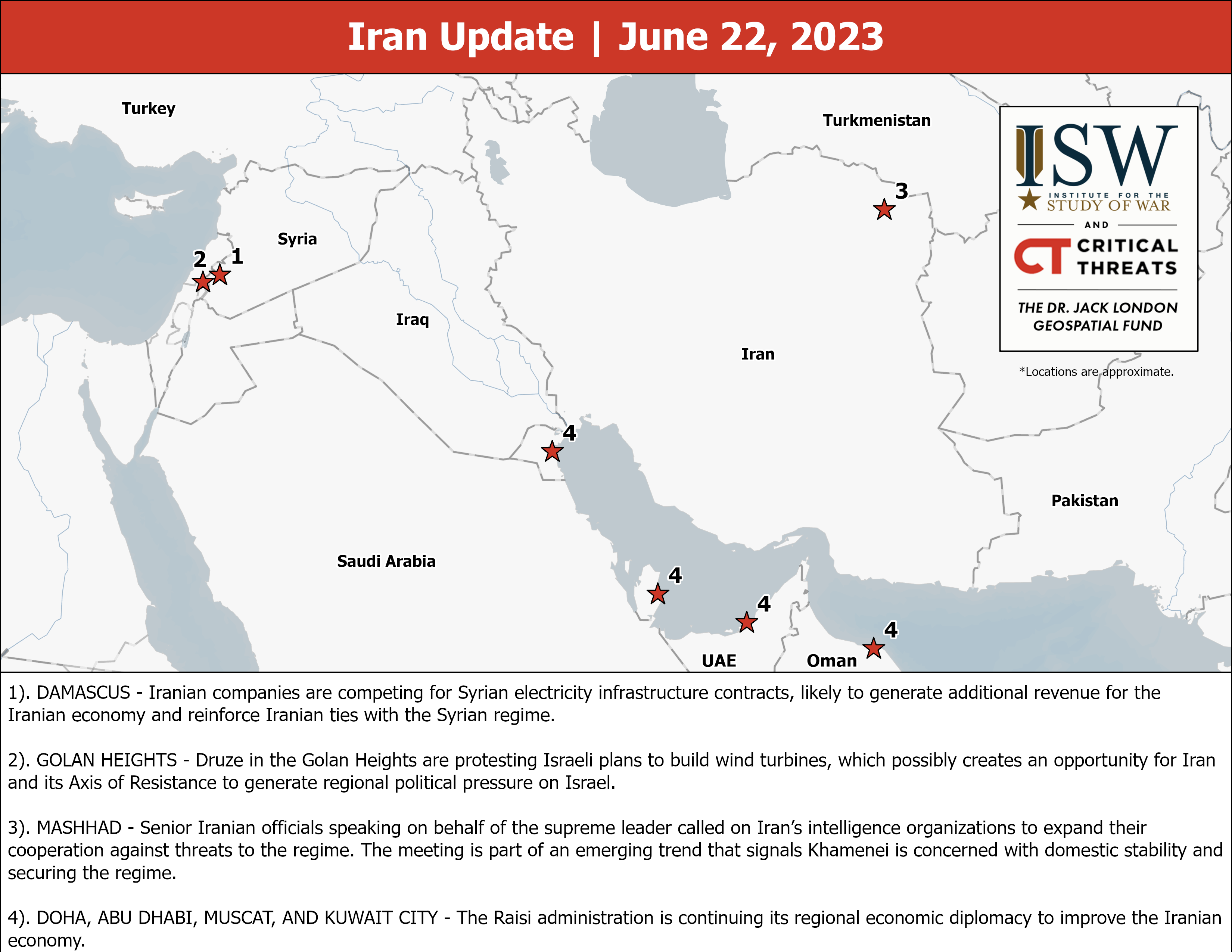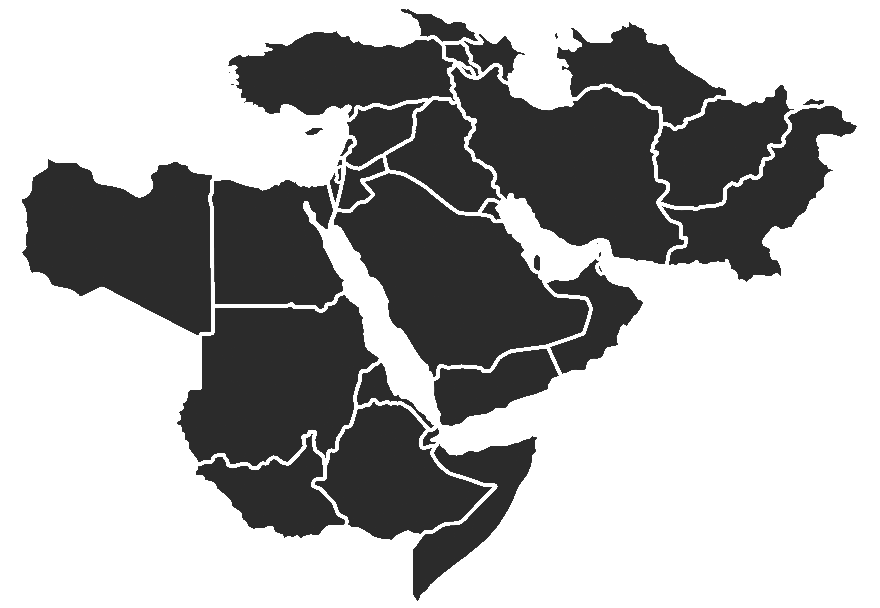{{currentView.title}}
June 22, 2023
Iran Update, June 22, 2023
The Iran Update aims to inform national security policy by providing timely, relevant, and independent open-source analysis of developments pertaining to Iran and its Axis of Resistance. This update covers political, military, and economic events and trends that affect the stability and decision-making of the Iranian regime. It also provides insights into Iranian and Iranian-sponsored activities abroad that undermine regional stability and threaten US forces and interests. The Critical Threats Project (CTP) at the American Enterprise Institute with support from the Institute for the Study of War (ISW) provides these updates Monday through Friday. To receive Iran Updates via email, please subscribe here.
The Institute for the Study of War (ISW) with support from the Critical Threats Project (CTP) at the American Enterprise Institute launched a new interactive map of Iran and the Middle East. The map depicts events in Iran that affect the stability of the Iranian regime, namely anti-regime protests and reported poisoning incidents. It also shows developments in Syria that jeopardize regional stability and pose threats to US forces and interests, including Iranian and Iranian-backed militia positions.
Key Takeaways
- Iranian companies are competing for Syrian electricity infrastructure contracts, likely to generate additional revenue for the Iranian economy and reinforce Iranian ties with the Syrian regime.
- Druze in the Golan Heights are protesting Israeli plans to build wind turbines, which possibly creates an opportunity for Iran and its Axis of Resistance to generate regional political pressure on Israel.
- Senior Iranian officials speaking on behalf of the supreme leader called on Iran’s intelligence organizations to expand their cooperation against threats to the regime. The meeting is part of an emerging trend that signals Khamenei is concerned with domestic stability and securing the regime.
- The Raisi administration is continuing its regional economic diplomacy to improve the Iranian economy.

Iranian Activities in the Levant
This section covers Iranian efforts to consolidate and expand Tehran’s economic, military, and political influence throughout the Levant and especially in Syria. This section examines some of the many campaigns that Iran is pursuing to achieve this strategic objective. CTP will update and refine our assessments of these campaigns over time and in future updates.
Iranian companies are competing for Syrian electricity infrastructure contracts, likely to generate additional revenue for the Iranian economy and reinforce Iranian ties with the Syrian regime. Syrian Electricity Minister Ghassan al Zamil met with Iranian businesspeople to discuss establishing hydroelectric dams in Syria on June 20 in Damascus.[i] This meeting comes after Iranian Energy Minister Ali Akbar Mehrabian announced that Iran will help rehabilitate the Syrian water and electricity industry on May 7.[ii] It also follows Iranian President Ebrahim Raisi’s visit to Syria from May 3-4, during which he and Syrian President Bashar al Assad signed 15 cooperation agreements and memorandums of understanding that cover oil, energy, transportation, reconstruction, and communications technology.[iii] The meeting demonstrates that Iran intends to be the primary provider of reconstruction projects in Syria.[iv]
Revenue from reconstruction contracts would increase capital flows to Iran, which would help reinvigorate Iran’s economy. Saudi Arabia and the United Arab Emirates have additionally lobbied European states to ease sanctions and restore relations with the Syrian regime over the past months.[v] Eight Arab states—Egypt, Iraq, Jordan, Lebanon, Libya, Palestine, Sudan, and Tunisia—also discussed rebuilding Syrian rail infrastructure at the Arab Railway Union conference in Damascus on June 20, the first conference of its kind in 11 years.[vi] Iran stands to benefit from the Arab states outreach and investment in Syria in that the lifting of sanctions and rebuilding the country’s trade routes would better position Syria to pay Iran for reconstruction projects. Syria was unable to pay Iran for two thermal electricity plant contracts in March and sought to cover the costs with phosphate. Iran rejected the bartering and the contracts fell through.[vii]
The Arab states reconstructing Syria’s rail infrastructure also likely would facilitate Iranian efforts to generate revenue through greater trade, as CTP previously assessed.[viii] Iran seeks to build a railway line linking Iran to Syria via Iraq to bolster its domestic economy, create regional economic dependency, and evade international sanctions. Iran and Iraq have agreed to railway projects in April and May 2023 with the stated aim of economic integration.[ix] Establishing these rail connections will provide Iran with a rail link to the Levant and the Mediterranean Sea, enabling Iran to reap greater trade profits despite sanctions. An Iran-Iraq-Syria railway would also facilitate Iranian and Syrian sanctions evasion through unsanctioned Iraqi ports.
Druze in the Golan Heights are protesting Israeli plans to build wind turbines, which possibly creates an opportunity for Iran and its Axis of Resistance to generate regional political pressure on Israel. Protesters and Israeli police clashed in the Golan Heights on June 20-22 as Israel began work on wind turbines, which resulted in at least 20 injuries.[x] The Syrian Foreign and Expatriates Ministry and Hamas—a US-designated Foreign Terrorist Organization (FTO)—condemned Israel's use of force in the territory.[xi] Druze residents have protested Israeli activity in the Golan Heights previously, however, such protests rarely result in violence.[xii] Israeli National Security Minister Itamar Ben Gvir met with Druze community leaders on June 22 and decided to pause wind turbine construction for Eid al Adha and continue immediately thereafter.[xiii] Iranian leaders encouraged conflict between Israel and Palestinian militias during a period of escalation after an Israeli raid on Al Aqsa Mosque in May.[xiv]
CTP is considering the hypothesis that Iran will exploit the Druze protests to stoke instability against Israel. This hypothesis is plausible because Iran and Lebanese Hezbollah (LH) have taken steps to entrench themselves in the Golan Heights and threaten Israel from there.[xv] LH in coordination with the IRGC Quds Force established the Golan File unit to build military infrastructure and gather intelligence in southern Syria, for instance.[xvi] LH has also tried to leverage its allies in the Golan Heights to drive division between Druze communities and assert influence over them.[xvii] Iran has not messaged any interest in exploiting the Druze protests, however, which makes this hypothesis unlikely. Iranian military officials meeting with regional proxies, such as Hamas and LH, or military planners from groups such as Palestinian Islamic Jihad as the protests continue would be an indication of Iran attempting to exploit the protests.
Iranian Domestic and Political Affairs
This section covers factors and trends affecting regime decision-making and stability. CTP will cover domestic politics, significant protest activity, and related issues here.
Senior Iranian officials speaking on behalf of the supreme leader called on Iran’s intelligence organizations to expand their cooperation against threats to the regime.[xviii] Numerous senior political, intelligence, and military officials convened in Mashhad, Khorasan Razavi Province to discuss cooperation between the IRGC Intelligence Organization (IRGC-IO) and Intelligence and Security Ministry (MOIS) on June 15. Supreme Leader Office Chief of Staff Mohammad Mohammadi Golpayegani presented a message from Supreme Leader Ali Khamenei, which said that the “lack of understanding” between the IRGC-IO and MOIS is a “weakness.”[xix] Supreme Leader Military Office Chief Brigadier General Mohammad Shirazi separately called on the IRGC-IO and MOIS to work together to prevent the “conspiracies and sedition” of Iran’s external enemies. The attendees, listed below, signal that Khamenei has given priority to securing the regime given the effects of the Mahsa Amini movement and potential for popular unrest during the upcoming elections.
- Supreme Leader Office Chief of Staff Mohammad Mohammadi Golpayegani
- Supreme Leader Military Office Chief Brigadier General Mohammad Shirazi
- IRGC Intelligence Organization Chief Brigadier General Mohammad Kazemi
- Intelligence and Security Minister Esmail Khatib
- IRGC Commander Major General Hossein Salami
- Supreme National Security Council Secretary Rear Admiral Ali Akbar Ahmadian
- Interior Minister Ahmad Vahidi
The meeting is part of an emerging trend that signals Khamenei is concerned with domestic stability and securing the regime. It follows statements from IRGC Intelligence Organization Chief Brigadier General Mohammad Kazemi that accused 18 countries of abetting the Mahsa Amini movement and warned of foreign intervention in Iran’s March 2024 parliamentary elections.[xx] Kazemi’s statements indicate the priority the IRGC-IO is giving to foreign intervention in Iran and the potential for widespread anti-regime protests. That the supreme leader’s website published Kazemi’s statements indicates that Khamenei is stressing the importance of internal security.[xxi]
Khamenei likely seeks to overcome historic rivalries between the IRGC-IO and MOIS.[xxii] Khamenei established the IRGC-IO as a parallel institution to the MOIS in 2009, although the IRGC-IO has increasingly overshadowed the MOIS since then.[xxiii] The IRGC-IO is regarded as the more ideological of the two institutions.[xxiv]
Iran’s intelligence agencies are discussing how to confront future sociocultural and political unrest and may extend their cooperation to external threats. Khatib stated during the June 15 meeting that the IRGC-IO and MOIS must develop joint strategies to ensure participation, competition, health, and security in Iran’s March 2024 parliamentary elections.[xxv] Several Iranian officials—including Khamenei—have claimed in recent weeks that Iran’s enemies intend to disrupt the elections.[xxvi] Khamenei may thus have ordered the IRGC-IO and MOIS to cooperate, in part, to ensure the parliamentary elections pass smoothly. Iran accused Israel of conducting several acts of sabotage on military and nuclear facilities inside Iran in recent months. Attacks on these facilities would hamper the regime’s ability to produce and sell military equipment, such as drones. The regime has also demonstrated heightened concern toward Kurdish opposition groups near Iran’s northwestern border with Iraq in recent weeks.[xxvii] Regime-aligned media previously accused Kurdish militants of helping Israel transfer equipment into Iran to strike Iranian facilities.[xxviii]
The Raisi administration is continuing its regional economic diplomacy to improve the Iranian economy. Foreign Affairs Minister Hossein Amir Abdollahian traveled to Kuwait, Oman, Qatar, and the UAE between June 19 and 22.[xxix] Abdollahian discussed increasing economic cooperation with his Gulf state counterparts, specifically regarding trade, energy, transportation, banking, communications technology, and private business. Abdollahian’s visits are part of the Raisi administration’s ”neighborhood policy,” which is an economic policy centered on building relations with regional and extra-regional states.[xxx] This neighborhood policy is meant to buoy the Iranian economy despite international sanctions. The policy has failed thus far to prevent the continual deterioration of the economy.
Iran may intend for Abdollahian’s outreach to generate interest in economic partnerships with an investment in Iran following a nuclear agreement with the West. Iran has engaged in indirect nuclear negotiations for a limited agreement with the US over the past several weeks.[xxxi] Iran’s chief nuclear negotiator Ali Bagheri Kani additionally discussed reviving the Joint Comprehensive Plan of Action with EU Foreign Affairs Representative Enrique Mora on June 21, signaling the regime‘s intent to reach a comprehensive agreement.[xxxii] Iran recently engaged in several prisoner exchanges with Western countries, which it intended to clear the path for resuming nuclear negotiations.[xxxiii] Iran is also appealing to the Gulf states to invest in the country following a comprehensive agreement that lifts secondary sanctions. Abdollahian, for example, emphasized private sector interaction during a meeting with his Qatari counterpart. CTP will develop and refine this assessment in future updates.
[i] https://www[dot]athrpress.com/%d8%a8%d9%8a%d9%86%d9%87%d8%a7-%d8%a5%d9%86%d8%aa%d8%a7%d8%ac-%d8%a7%d9%84%d9%83%d9%87%d8%b1%d8%a8%d8%a7%d8%a1-%d8%b9%d8%a8%d8%b1-%d8%a7%d9%84%d9%85%d9%8a%d8%a7%d9%87-%d9%81%d9%8a-%d8%b3%d9%88%d8%b1/%d8%a3%d8%ab%d8%b1-%d9%85%d8%ad%d9%84%d9%8a/
[ii] https://www[dot]irna.ir/news/85103434/%D9%85%D8%AD%D8%B1%D8%A7%D8%A8%DB%8C%D8%A7%D9%86-%D8%A7%DB%8C%D8%B1%D8%A7%D9%86-%D8%A2%D9%85%D8%A7%D8%AF%D9%87-%D9%85%D8%B4%D8%A7%D8%B1%DA%A9%D8%AA-%D8%AF%D8%B1-%D8%A8%D8%A7%D8%B2%D8%B3%D8%A7%D8%B2%DB%8C-%D8%B5%D9%86%D8%B9%D8%AA-%D8%A2%D8%A8-%D9%88-%D8%A8%D8%B1%D9%82-%D8%B3%D9%88%D8%B1%DB%8C%D9%87-%D8%A7%D8%B3%D8%AA
[iii] https://www.farsnews dot ir/news/14020213000875
[iv] https://www.almayadeen dot net/news/politics/%D8%A7%D9%84%D8%B1%D8%A6%D9%8A%D8%B3-%D8%A7%D9%84%D8%A5%D9%8A%D8%B1%D8%A7%D9%86%D9%8A-%D9%84%D9%84%D9%85%D9%8A%D8%A7%D8%AF%D9%8A%D9%86:-%D8%B9%D9%84%D8%A7%D9%82%D8%AA%D9%86%D8%A7-%D9%85%D8%B3%D8%AA%D9%85%D8%B1%D8%A9-%D9%85%D8%B9-%D8%B3%D9%88%D8%B1%D9%8A%D8%A7-%D8%B6%D9%85%D9%86-%D8%AC%D8%A8%D9%87%D8%A9-%D8%A7
[v] https://www.bloomberg.com/news/articles/2023-06-15/saudis-uae-lobby-europeans-to-restore-ties-with-syria-s-assad
[vi] https://sana [dot] sy/?p=1919175
[vii] https://shaam[dot]org/news/syria-news/shrkh-iyranyh-trfdh-msuwl-ykshf-tfasyl-tathr-tahyl-mhth-mhrdh ; https://www.alaraby.co.uk/node/6323479
[viii] https://www.understandingwar.org/backgrounder/iran-update-june-21-2023
[ix] https://www.presstv [dot] ir/Detail/2023/04/06/701083/Iran-Iraq-railway-link-budget-allocation
[x] https://apnews.com/article/israel-druze-golan-syria-1630cc39ebe1839d4dd1c05d92fd44d9; https://www (dot) haaretz.com/israel-news/2023-06-20/ty-article/.premium/druze-protesters-clash-with-police-in-golan-heights-over-wind-turbine-construction/00000188-d970-d5fc-ab9d-db7870610000; https://www.aljazeera (dot) com/news/2023/6/22/israeli-army-uses-force-against-druze-protests-in-occupied-golan
[xi] https://hamas (dot) ps/ar/p/17532; https://sana (dot) sy/en/?p=311528; https://www.state.gov/foreign-terrorist-organizations/
[xii] https://www.aljazeera (dot) com/news/2023/6/22/israeli-army-uses-force-against-druze-protests-in-occupied-golan
[xiii] https://twitter.com/itamarbengvir/status/1671924431407529988
[xiv] https://www.criticalthreats.org/analysis/iran-update-may-15-2023
[xv] https://www.jpost (dot) com/middle-east/iran-vows-to-liberate-golan-heights-from-israel-647237
[xvi] https://israel-alma (dot) org/2020/10/20/hezbollah-southern-syria-deployment-of-the-southern-command-and-the-golan-file-units/; https://www (dot) timesofisrael.com/idf-says-it-has-exposed-new-hezbollah-cell-operating-from-syrian-golan-heights/
[xvii] https://www.mei.edu/publications/divide-and-conquer-growing-hezbollah-threat-druze
[xviii] https://defapress dot ir/fa/news/598614/نشست-مشترک-وزارت-اطلاعات-و-سازمان-اطلاعات-سپاه-برگزار-شد
[xix] https://defapress dot ir/fa/news/598614/نشست-مشترک-وزارت-اطلاعات-و-سازمان-اطلاعات-سپاه-برگزار-شد
[xx] https://farsi.khamenei for ir/others-dialog?id=53161
[xxi] https://www.criticalthreats.org/analysis/iran-update-june-20-2023
[xxii] https://www.dia.mil/Portals/110/Images/News/Military_Powers_Publications/Iran_Military_Power_LR.pdf
[xxiii] https://amwaj.media/article/scoop-irgc-spy-chief-travels-to-iraq
[xxiv] https://www.nytimes.com/interactive/2019/11/18/world/middleeast/iran-iraq-spy-cables.html
[xxv] https://defapress dot ir/fa/news/597841
[xxvi] https://www.leader dot ir/fa/content/26528
[xxvii] https://www.criticalthreats.org/analysis/iran-update-may-30-2023
[xxviii] https://nournews dot ir/Fa/News/127294
[xxix] https://mfa dot ir/portal/NewsView/722758 ; https://mfa dot ir/portal/NewsView/722800 ; https://mfa dot ir/portal/NewsView/722795 ; https://mfa dot ir/portal/NewsView/722798 ; https://mfa dot ir/portal/NewsView/722794 ; https://mfa dot ir/portal/NewsView/722765 ; https://mfa dot ir/portal/NewsView/722639 ; https://www.irna dot ir/news/85147562 ; https://www.irna dot ir/news/85147574
[xxx] https://www.criticalthreats.org/analysis/iran-update-june-21-2023 ; https://www.criticalthreats.org/analysis/iran-update-june-20-2023 ; https://www.criticalthreats.org/analysis/iran-update-may-31-2023
[xxxi] https://www.criticalthreats.org/analysis/iran-update-june-15-2023#_edn49c170e7e6c183d52d28332649a99201b7c65a432893985bfa08d8a87515b6727 ; https://www.nytimes.com/2023/06/14/us/politics/biden-iran-nuclear-program.html ; https://www.wsj.com/articles/u-s-launches-quiet-diplomatic-push-with-iran-to-cool-tensions-2f45af3
[xxxii] https://www.tasnimnews dot com/fa/news/1402/04/01/2914736 ; https://www.cnn.com/2023/06/21/middleeast/iran-talks-kani-mora-intl/index.html
[xxxiii] https://www.criticalthreats.org/analysis/iran-update-may-26-2023
